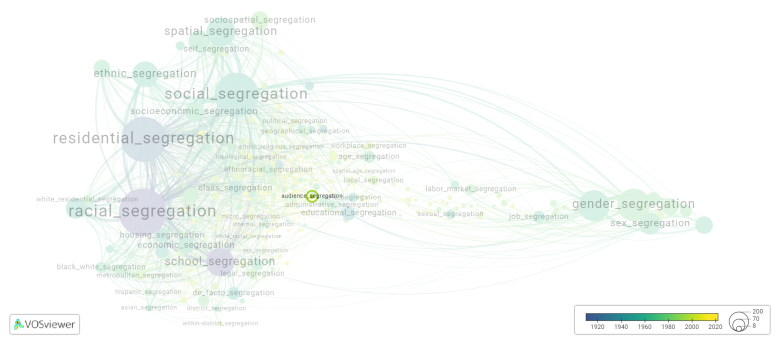Audience segregation: Difference between revisions
(Creating page) |
(Creating page) |
||
| (9 intermediate revisions by the same user not shown) | |||
| Line 1: | Line 1: | ||
===== Date and country of first publication<ref>Date and country of first publication as informed by the Scopus database (December 2023).</ref>===== | |||
2005<br> | 2005<br> | ||
United | United States | ||
===== Definition ===== | |||
Audience segregation refers to the process of dividing a target audience into specific groups based on demographic, psychographic, or behavioral characteristics. This segmentation allows marketers to tailor their messaging, products, and services to better meet the unique needs and preferences of each group. By understanding the different segments within their audience, businesses can create more targeted and effective marketing strategies that result in higher engagement and conversions. | Audience segregation refers to the process of dividing a target audience into specific groups based on demographic, psychographic, or behavioral characteristics. This segmentation allows marketers to tailor their messaging, products, and services to better meet the unique needs and preferences of each group. By understanding the different segments within their audience, businesses can create more targeted and effective marketing strategies that result in higher engagement and conversions. | ||
==See also== | ==See also== | ||
==Related segregation forms== | |||
Audience segregation is frequently discussed in the literature with the following segregation forms: | |||
[[friend segregation]] | |||
[[File:audience_segregation.png|780x780px]] | |||
This visualization is based on the study [[Segregation_Wiki:About| The Multidisciplinary Landscape of Segregation Research]]. | |||
For the complete network of interrelated segregation forms, please refer to: | |||
* [https://tinyurl.com/2235lkhw First year of publication] | |||
* [https://tinyurl.com/2d8wg5n3 Louvain clusters] | |||
* [https://tinyurl.com/223udk5r Betweenness centrality] | |||
* [https://tinyurl.com/244d8unz Disciplines in which segregation forms first emerged (Scopus database).] | |||
==References== | ==References== | ||
==Notes== | ==Notes== | ||
<references /> | <references /> | ||
== | {{NoteAI}} | ||
==Audience segregation appears in the following literature== | |||
Lotz A.D. (2005). Segregated sitcoms: Institutional causes of disparity among black and white comedy images and audiences. ''The Sitcom Reader: America Viewed and Skewed'', 139-150. State University of New York Press.https://doi.org/ | |||
Van Den Berg B., Leenes R. (2011). Keeping up appearances: Audience segregation in social network sites. ''Computers, Privacy and Data Protection: an Element of Choice'', 211-231. Springer Netherlands.https://doi.org/10.1007/978-94-007-0641-5_10 | |||
Austin L. (2012). The privacy interest in anonymous blogging. ''Amateur Media: Social, cultural and legal perspectives'', 208-214. Taylor and Francis.https://doi.org/10.4324/9780203112021-28 | |||
Korenhof P. (2014). Stage ahoy!deconstruction of the “drunken pirate”case in the light of impression management. ''Reloading Data Protection: Multidisciplinary Insights and Contemporary Challenges'', 79-97. Springer Netherlands.https://doi.org/10.1007/978-94-007-7540-4_5 | |||
Ahmed J., Villata S., Governatori G. (2019). Information and friend segregation for online social networks: a user study. ''AI and Society'', ''34''(4), 753-766. Springer London.https://doi.org/10.1007/s00146-017-0789-1 | |||
Laguecir A., Leca B. (2019). Strategies of visibility in contemporary surveillance settings: Insights from misconduct concealment in financial markets. ''Critical Perspectives on Accounting'', ''62''(), 39-58. Academic Press.https://doi.org/10.1016/j.cpa.2018.10.002 | |||
Latest revision as of 07:17, 16 October 2024
Date and country of first publication[1][edit | edit source]
2005
United States
Definition[edit | edit source]
Audience segregation refers to the process of dividing a target audience into specific groups based on demographic, psychographic, or behavioral characteristics. This segmentation allows marketers to tailor their messaging, products, and services to better meet the unique needs and preferences of each group. By understanding the different segments within their audience, businesses can create more targeted and effective marketing strategies that result in higher engagement and conversions.
See also[edit | edit source]
Related segregation forms[edit | edit source]
Audience segregation is frequently discussed in the literature with the following segregation forms:
This visualization is based on the study The Multidisciplinary Landscape of Segregation Research.
For the complete network of interrelated segregation forms, please refer to:
References[edit | edit source]
Notes[edit | edit source]
- ↑ Date and country of first publication as informed by the Scopus database (December 2023).
At its current state, this definition has been generated by a Large Language Model (LLM) so far without review by an independent researcher or a member of the curating team of segregation experts that keep the Segregation Wiki online. While we strive for accuracy, we cannot guarantee its reliability, completeness and timeliness. Please use this content with caution and verify information as needed. Also, feel free to improve on the definition as you see fit, including the use of references and other informational resources. We value your input in enhancing the quality and accuracy of the definitions of segregation forms collectively offered in the Segregation Wiki ©.
Audience segregation appears in the following literature[edit | edit source]
Lotz A.D. (2005). Segregated sitcoms: Institutional causes of disparity among black and white comedy images and audiences. The Sitcom Reader: America Viewed and Skewed, 139-150. State University of New York Press.https://doi.org/
Van Den Berg B., Leenes R. (2011). Keeping up appearances: Audience segregation in social network sites. Computers, Privacy and Data Protection: an Element of Choice, 211-231. Springer Netherlands.https://doi.org/10.1007/978-94-007-0641-5_10
Austin L. (2012). The privacy interest in anonymous blogging. Amateur Media: Social, cultural and legal perspectives, 208-214. Taylor and Francis.https://doi.org/10.4324/9780203112021-28
Korenhof P. (2014). Stage ahoy!deconstruction of the “drunken pirate”case in the light of impression management. Reloading Data Protection: Multidisciplinary Insights and Contemporary Challenges, 79-97. Springer Netherlands.https://doi.org/10.1007/978-94-007-7540-4_5
Ahmed J., Villata S., Governatori G. (2019). Information and friend segregation for online social networks: a user study. AI and Society, 34(4), 753-766. Springer London.https://doi.org/10.1007/s00146-017-0789-1
Laguecir A., Leca B. (2019). Strategies of visibility in contemporary surveillance settings: Insights from misconduct concealment in financial markets. Critical Perspectives on Accounting, 62(), 39-58. Academic Press.https://doi.org/10.1016/j.cpa.2018.10.002

